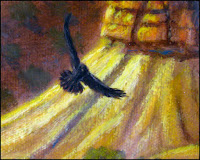Finding light in the desert...well, OK, it's normally not hard to find light in the desert, of all places. But finding the
right kind of light can be problematic.
One of the major blessings of living so close to Joshua Tree National Park -- a place I love to paint -- is being able to pop on over there any time I need to so I can be there when the time -- and the lighting -- is right.
 |
| Dawn |
The above image is one of my prints that is available at
FineArtAmerica.com. I went to the Park just before sunrise so I could be in a good spot to capture the rising sun along with some Joshua trees and the monzogranite rock formations that climbers love to scramble over.
For, you see, it isn't just any kind of light that I look for. Lighting changes so much during the day and in different seasons. Early-morning and pre-sunset light (my favorites) come from different directions, and summer lighting at those times comes from further north than winter lighting which is more from the south. As both a photographer and a painter (especially the latter), it helps to go to the Park knowing what kind of light to expect. And since I know the Park reasonably well, I often know
where I need to go to take advantage of the light I'll find.
In fact, sometimes I develop an idea for a painting and then go to where I will find a locale to match. Sometimes I'll wait as long as six months to return to the site i want to photograph/paint because I know the lighting will be what I want to depict.
The photo above that I took will assist me in a painting I want to make, hopefully soon. Since I wanted to offer it as a print, too, and I don't have an ultra high-resolution camera that costs more than our house, I had to Photoshop it just a little -- I used a watercolor look which a.) makes it appear to be a watercolor painting, and 2.) hides the blurred edges that would show at larger magnifications since my camera is only an 8MP camera. And: I cheated and added the image of the red-tailed hawk in flight. Personally, I think the image turned out well.
In the end, both photography and painting work better when the artist chooses his/her lighting carefully. And if the artist lives close to a place that makes it quick and easy to get to a favorite spot when the lighting is fantastic, so much the better.

























